BCO6603: ERP Systems Journey - Case Studies and Analysis
VerifiedAdded on 2022/08/25
|14
|3720
|20
Report
AI Summary
This research report explores the multifaceted journey of Enterprise Resource Planning (ERP) systems, arguing that 'going live' is not the ultimate endpoint but rather a significant milestone in a continuous evolution. The report delves into the background and benefits of ERP systems, highlighting their role in integrating various business functions, from customer relationship management to data management. It then outlines the stages of an ERP systems journey, including discovery and planning, design, development, and testing and deployment. The report examines the potential benefits at each stage, such as improved data visibility, streamlined reporting, and enhanced customer service. Furthermore, it analyzes the drivers and barriers that influence a company's progression through these stages. The report uses case studies of companies like Hershey’s and Cadbury to illustrate the impact of different implementation strategies and their consequences. The report also discusses the issues with ERP, like high implementation costs and a lack of skilled employees. Overall, the report provides a comprehensive analysis of the ERP journey and its implications for business organizations.

Running Head: ENTERPRISE RESOURCE PLANNING
Going Live Is Not the End of the ERP Journey
Name of the Student
Name of the University
Going Live Is Not the End of the ERP Journey
Name of the Student
Name of the University
Paraphrase This Document
Need a fresh take? Get an instant paraphrase of this document with our AI Paraphraser
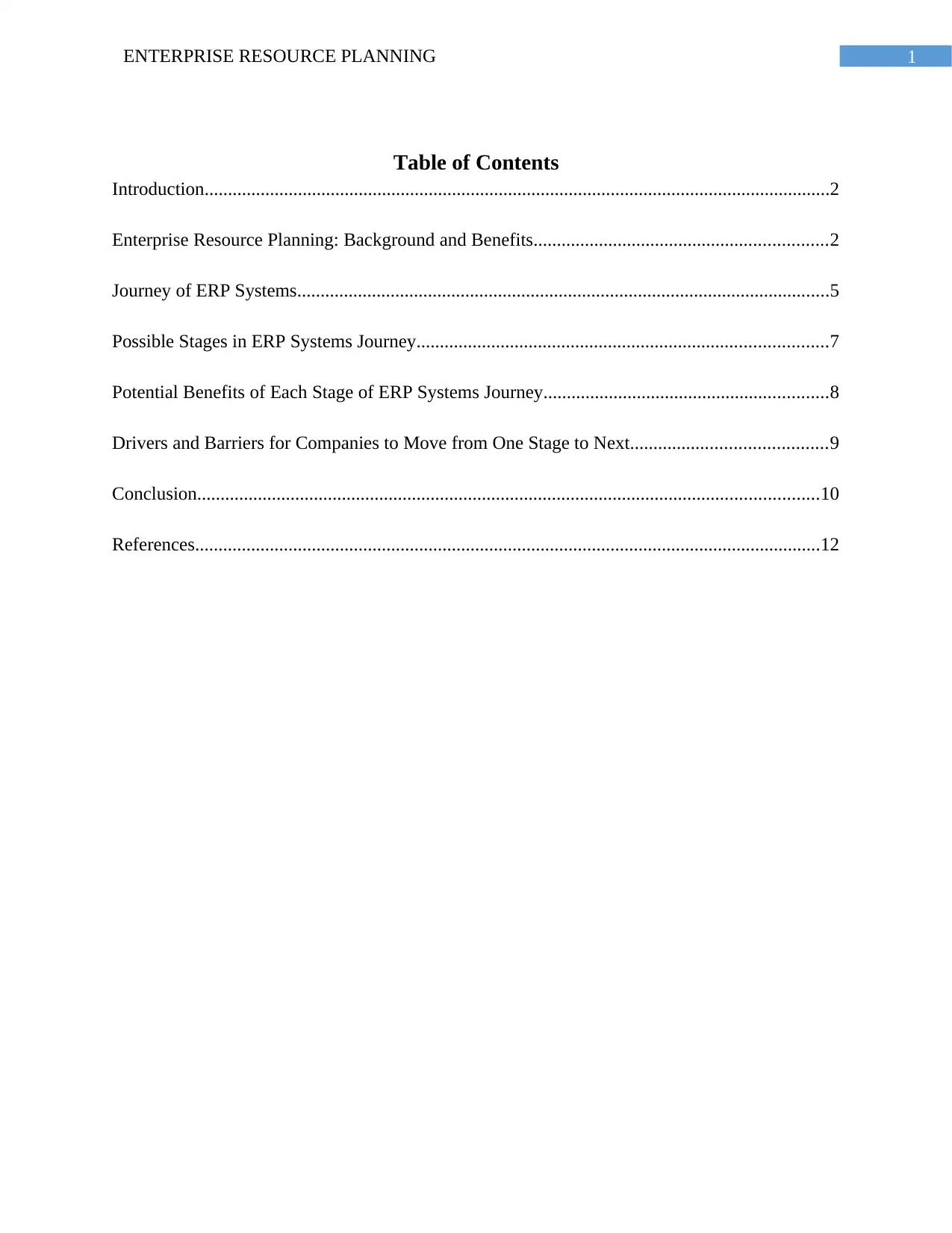
1ENTERPRISE RESOURCE PLANNING
Table of Contents
Introduction......................................................................................................................................2
Enterprise Resource Planning: Background and Benefits...............................................................2
Journey of ERP Systems..................................................................................................................5
Possible Stages in ERP Systems Journey........................................................................................7
Potential Benefits of Each Stage of ERP Systems Journey.............................................................8
Drivers and Barriers for Companies to Move from One Stage to Next..........................................9
Conclusion.....................................................................................................................................10
References......................................................................................................................................12
Table of Contents
Introduction......................................................................................................................................2
Enterprise Resource Planning: Background and Benefits...............................................................2
Journey of ERP Systems..................................................................................................................5
Possible Stages in ERP Systems Journey........................................................................................7
Potential Benefits of Each Stage of ERP Systems Journey.............................................................8
Drivers and Barriers for Companies to Move from One Stage to Next..........................................9
Conclusion.....................................................................................................................................10
References......................................................................................................................................12

2ENTERPRISE RESOURCE PLANNING
Introduction
Enterprise Resource Planning or ERP in short is a software based solution that helps a
business organisation to integrate all its features within the same operational platform. The
features that are integrated by the ERP system include customer relationship management,
customer information, business analytics, business statistics, data storage and management and
many others. With the growing need of utilising and maximising the benefits of information
technology in business, more and more business organisations are moving to implement ERP
system within their operation (Altamony, Al-Salti, Gharaibeh and Elyas, 2016). ERP systems not
only help to integrate all the features within the platform, it is also one of the main tools for the
company to go live after everything has been integrated. However, this is a slow process and
mainly involves various stages referred to as ERP implementation stages. Some companies often
have the idea that going live is the final step for ERP implementation and there is no beyond.
This is not true as ERP systems have significant potential to be much more due to the evolution
of the computing technology.
The main aim of this report is to conduct research on ERP systems, discuss the stages of
implementation of ERP systems and its benefits and issues in the current business organisations.
Enterprise Resource Planning: Background and Benefits
Since the beginning of the 21st century, the concept of ERP systems came into being as
various researchers mentioned that the ERP system is the key that can be extensively utilised in
order to mitigate various business related problems faced by the companies. The primary benefit
that can be realised with the utilisation of the ERP system would be the integration of various
features of business within the common platform that can be utilised by the company (Chofreh,
Introduction
Enterprise Resource Planning or ERP in short is a software based solution that helps a
business organisation to integrate all its features within the same operational platform. The
features that are integrated by the ERP system include customer relationship management,
customer information, business analytics, business statistics, data storage and management and
many others. With the growing need of utilising and maximising the benefits of information
technology in business, more and more business organisations are moving to implement ERP
system within their operation (Altamony, Al-Salti, Gharaibeh and Elyas, 2016). ERP systems not
only help to integrate all the features within the platform, it is also one of the main tools for the
company to go live after everything has been integrated. However, this is a slow process and
mainly involves various stages referred to as ERP implementation stages. Some companies often
have the idea that going live is the final step for ERP implementation and there is no beyond.
This is not true as ERP systems have significant potential to be much more due to the evolution
of the computing technology.
The main aim of this report is to conduct research on ERP systems, discuss the stages of
implementation of ERP systems and its benefits and issues in the current business organisations.
Enterprise Resource Planning: Background and Benefits
Since the beginning of the 21st century, the concept of ERP systems came into being as
various researchers mentioned that the ERP system is the key that can be extensively utilised in
order to mitigate various business related problems faced by the companies. The primary benefit
that can be realised with the utilisation of the ERP system would be the integration of various
features of business within the common platform that can be utilised by the company (Chofreh,
⊘ This is a preview!⊘
Do you want full access?
Subscribe today to unlock all pages.

Trusted by 1+ million students worldwide
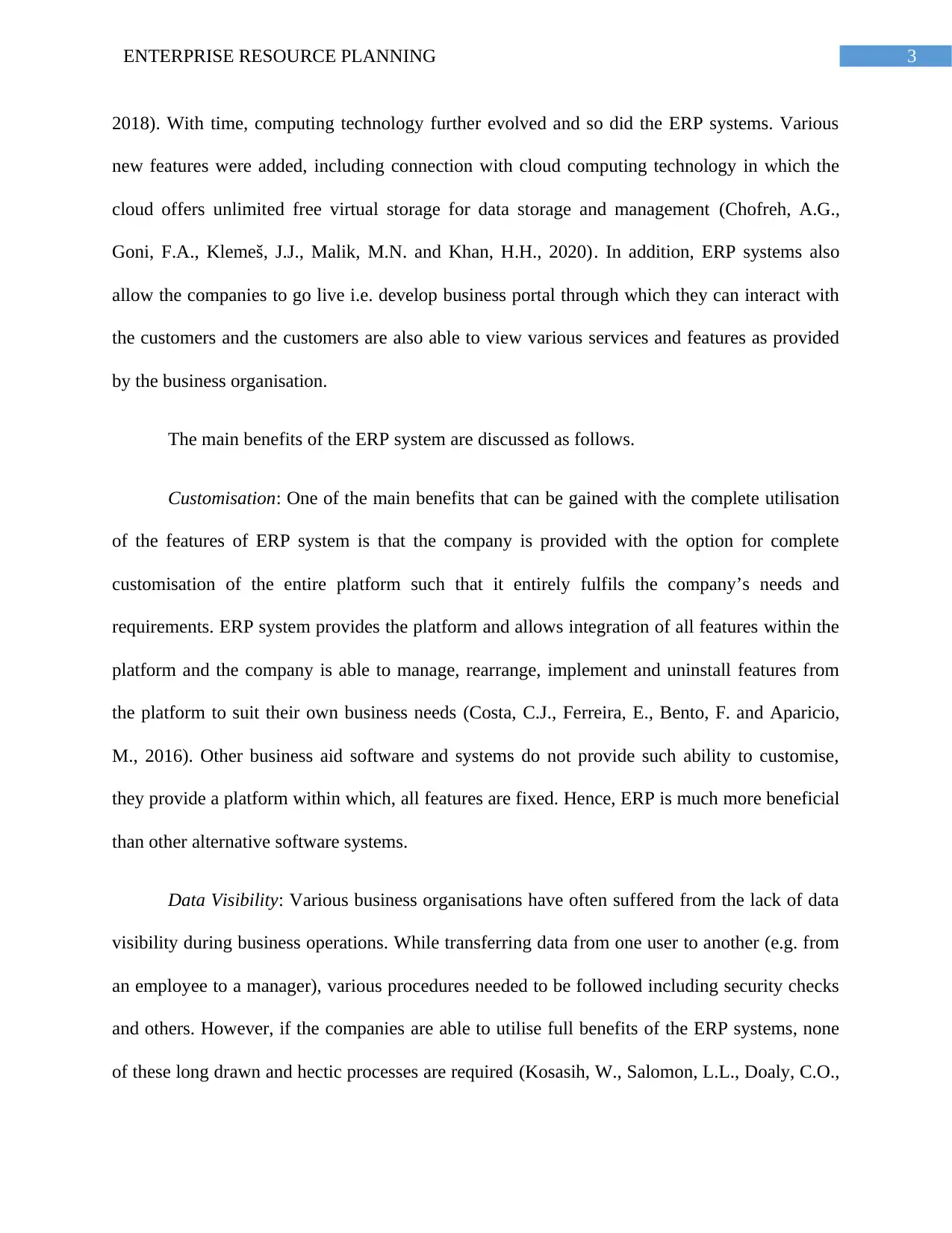
3ENTERPRISE RESOURCE PLANNING
2018). With time, computing technology further evolved and so did the ERP systems. Various
new features were added, including connection with cloud computing technology in which the
cloud offers unlimited free virtual storage for data storage and management (Chofreh, A.G.,
Goni, F.A., Klemeš, J.J., Malik, M.N. and Khan, H.H., 2020). In addition, ERP systems also
allow the companies to go live i.e. develop business portal through which they can interact with
the customers and the customers are also able to view various services and features as provided
by the business organisation.
The main benefits of the ERP system are discussed as follows.
Customisation: One of the main benefits that can be gained with the complete utilisation
of the features of ERP system is that the company is provided with the option for complete
customisation of the entire platform such that it entirely fulfils the company’s needs and
requirements. ERP system provides the platform and allows integration of all features within the
platform and the company is able to manage, rearrange, implement and uninstall features from
the platform to suit their own business needs (Costa, C.J., Ferreira, E., Bento, F. and Aparicio,
M., 2016). Other business aid software and systems do not provide such ability to customise,
they provide a platform within which, all features are fixed. Hence, ERP is much more beneficial
than other alternative software systems.
Data Visibility: Various business organisations have often suffered from the lack of data
visibility during business operations. While transferring data from one user to another (e.g. from
an employee to a manager), various procedures needed to be followed including security checks
and others. However, if the companies are able to utilise full benefits of the ERP systems, none
of these long drawn and hectic processes are required (Kosasih, W., Salomon, L.L., Doaly, C.O.,
2018). With time, computing technology further evolved and so did the ERP systems. Various
new features were added, including connection with cloud computing technology in which the
cloud offers unlimited free virtual storage for data storage and management (Chofreh, A.G.,
Goni, F.A., Klemeš, J.J., Malik, M.N. and Khan, H.H., 2020). In addition, ERP systems also
allow the companies to go live i.e. develop business portal through which they can interact with
the customers and the customers are also able to view various services and features as provided
by the business organisation.
The main benefits of the ERP system are discussed as follows.
Customisation: One of the main benefits that can be gained with the complete utilisation
of the features of ERP system is that the company is provided with the option for complete
customisation of the entire platform such that it entirely fulfils the company’s needs and
requirements. ERP system provides the platform and allows integration of all features within the
platform and the company is able to manage, rearrange, implement and uninstall features from
the platform to suit their own business needs (Costa, C.J., Ferreira, E., Bento, F. and Aparicio,
M., 2016). Other business aid software and systems do not provide such ability to customise,
they provide a platform within which, all features are fixed. Hence, ERP is much more beneficial
than other alternative software systems.
Data Visibility: Various business organisations have often suffered from the lack of data
visibility during business operations. While transferring data from one user to another (e.g. from
an employee to a manager), various procedures needed to be followed including security checks
and others. However, if the companies are able to utilise full benefits of the ERP systems, none
of these long drawn and hectic processes are required (Kosasih, W., Salomon, L.L., Doaly, C.O.,
Paraphrase This Document
Need a fresh take? Get an instant paraphrase of this document with our AI Paraphraser
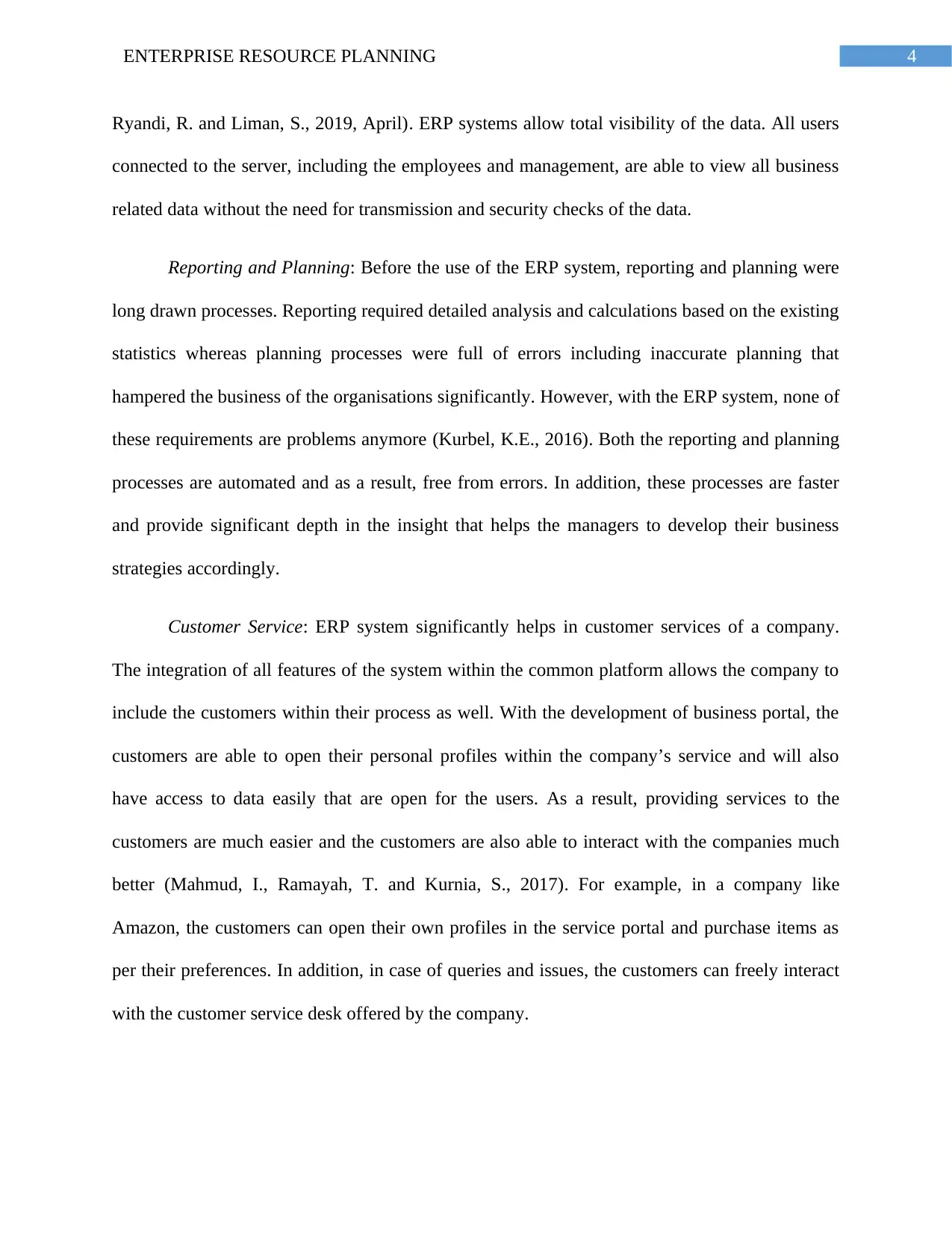
4ENTERPRISE RESOURCE PLANNING
Ryandi, R. and Liman, S., 2019, April). ERP systems allow total visibility of the data. All users
connected to the server, including the employees and management, are able to view all business
related data without the need for transmission and security checks of the data.
Reporting and Planning: Before the use of the ERP system, reporting and planning were
long drawn processes. Reporting required detailed analysis and calculations based on the existing
statistics whereas planning processes were full of errors including inaccurate planning that
hampered the business of the organisations significantly. However, with the ERP system, none of
these requirements are problems anymore (Kurbel, K.E., 2016). Both the reporting and planning
processes are automated and as a result, free from errors. In addition, these processes are faster
and provide significant depth in the insight that helps the managers to develop their business
strategies accordingly.
Customer Service: ERP system significantly helps in customer services of a company.
The integration of all features of the system within the common platform allows the company to
include the customers within their process as well. With the development of business portal, the
customers are able to open their personal profiles within the company’s service and will also
have access to data easily that are open for the users. As a result, providing services to the
customers are much easier and the customers are also able to interact with the companies much
better (Mahmud, I., Ramayah, T. and Kurnia, S., 2017). For example, in a company like
Amazon, the customers can open their own profiles in the service portal and purchase items as
per their preferences. In addition, in case of queries and issues, the customers can freely interact
with the customer service desk offered by the company.
Ryandi, R. and Liman, S., 2019, April). ERP systems allow total visibility of the data. All users
connected to the server, including the employees and management, are able to view all business
related data without the need for transmission and security checks of the data.
Reporting and Planning: Before the use of the ERP system, reporting and planning were
long drawn processes. Reporting required detailed analysis and calculations based on the existing
statistics whereas planning processes were full of errors including inaccurate planning that
hampered the business of the organisations significantly. However, with the ERP system, none of
these requirements are problems anymore (Kurbel, K.E., 2016). Both the reporting and planning
processes are automated and as a result, free from errors. In addition, these processes are faster
and provide significant depth in the insight that helps the managers to develop their business
strategies accordingly.
Customer Service: ERP system significantly helps in customer services of a company.
The integration of all features of the system within the common platform allows the company to
include the customers within their process as well. With the development of business portal, the
customers are able to open their personal profiles within the company’s service and will also
have access to data easily that are open for the users. As a result, providing services to the
customers are much easier and the customers are also able to interact with the companies much
better (Mahmud, I., Ramayah, T. and Kurnia, S., 2017). For example, in a company like
Amazon, the customers can open their own profiles in the service portal and purchase items as
per their preferences. In addition, in case of queries and issues, the customers can freely interact
with the customer service desk offered by the company.

5ENTERPRISE RESOURCE PLANNING
In spite of all these benefits, there are certain issues of ERP system as well that may not
make it suitable for the small and medium sized organisation. The first main problem is that the
implementation process for such a software based system is very expensive. Since the
implementation takes years to complete, the costs also increase exponentially after a time. As the
large scale organisations are able to reap benefits from the system, they are able to handle the
implementation costs for the ERP system. On the other hand, most of the small and medium
scale organisations are not able to handle the costs for implementation and often, they chose not
to implement ERP system (Masa'deh, E.Y.R.A., Mufleh, M. and Alrowwad, A.A., 2017).
Another major problem of the ERP system is the time taken for implementation. ERP
implementation takes months or even years to complete considering there are several stages of
implementation, each of which requires significant amount of time. Most of the small and
medium scale organisations are not viable enough to support the ERP system for years and as a
result, the ERP system is not suitable for them. The final problem for implementing ERP is the
lack of skill set of most employees in business organisations. Even few years ago, there were to
ERP training available in the academic institutions and hence, the employees have very limited
knowledge and skills related to ERP. As a result, the companies have to provide training to the
employees once the ERP system is implemented and it takes months or even years for the
employees to become proficient with the handling of ERP system.
Journey of ERP Systems
Considering the history of ERP system in the world, it has been said that the journey of
ERP systems has not been long but very rough. While some companies have been able to utilise
ERP systems by realising all its features and benefits, other companies failed horribly and had
gone behind the market competitors after the implementation of ERP. Whether the ERP systems
In spite of all these benefits, there are certain issues of ERP system as well that may not
make it suitable for the small and medium sized organisation. The first main problem is that the
implementation process for such a software based system is very expensive. Since the
implementation takes years to complete, the costs also increase exponentially after a time. As the
large scale organisations are able to reap benefits from the system, they are able to handle the
implementation costs for the ERP system. On the other hand, most of the small and medium
scale organisations are not able to handle the costs for implementation and often, they chose not
to implement ERP system (Masa'deh, E.Y.R.A., Mufleh, M. and Alrowwad, A.A., 2017).
Another major problem of the ERP system is the time taken for implementation. ERP
implementation takes months or even years to complete considering there are several stages of
implementation, each of which requires significant amount of time. Most of the small and
medium scale organisations are not viable enough to support the ERP system for years and as a
result, the ERP system is not suitable for them. The final problem for implementing ERP is the
lack of skill set of most employees in business organisations. Even few years ago, there were to
ERP training available in the academic institutions and hence, the employees have very limited
knowledge and skills related to ERP. As a result, the companies have to provide training to the
employees once the ERP system is implemented and it takes months or even years for the
employees to become proficient with the handling of ERP system.
Journey of ERP Systems
Considering the history of ERP system in the world, it has been said that the journey of
ERP systems has not been long but very rough. While some companies have been able to utilise
ERP systems by realising all its features and benefits, other companies failed horribly and had
gone behind the market competitors after the implementation of ERP. Whether the ERP systems
⊘ This is a preview!⊘
Do you want full access?
Subscribe today to unlock all pages.

Trusted by 1+ million students worldwide
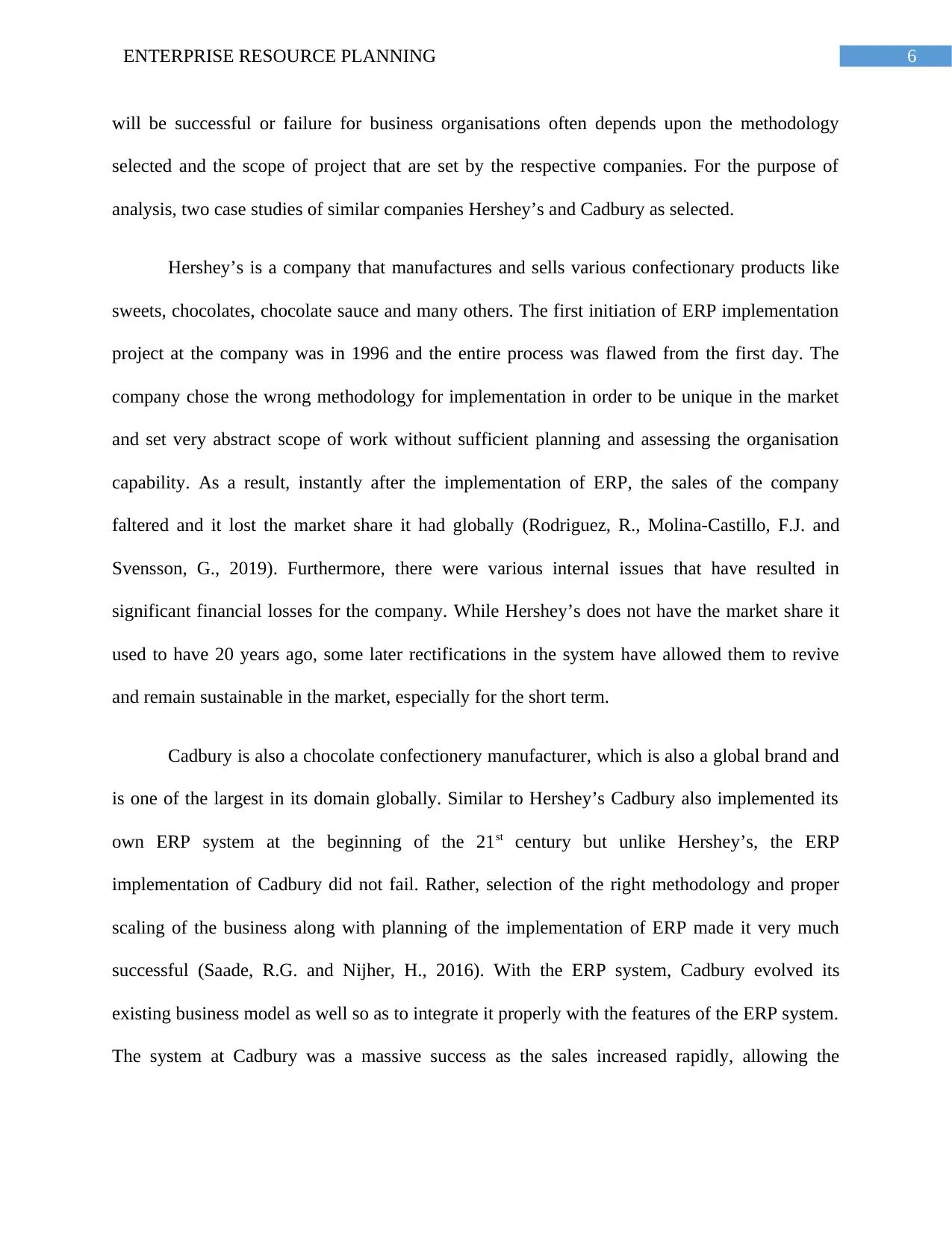
6ENTERPRISE RESOURCE PLANNING
will be successful or failure for business organisations often depends upon the methodology
selected and the scope of project that are set by the respective companies. For the purpose of
analysis, two case studies of similar companies Hershey’s and Cadbury as selected.
Hershey’s is a company that manufactures and sells various confectionary products like
sweets, chocolates, chocolate sauce and many others. The first initiation of ERP implementation
project at the company was in 1996 and the entire process was flawed from the first day. The
company chose the wrong methodology for implementation in order to be unique in the market
and set very abstract scope of work without sufficient planning and assessing the organisation
capability. As a result, instantly after the implementation of ERP, the sales of the company
faltered and it lost the market share it had globally (Rodriguez, R., Molina-Castillo, F.J. and
Svensson, G., 2019). Furthermore, there were various internal issues that have resulted in
significant financial losses for the company. While Hershey’s does not have the market share it
used to have 20 years ago, some later rectifications in the system have allowed them to revive
and remain sustainable in the market, especially for the short term.
Cadbury is also a chocolate confectionery manufacturer, which is also a global brand and
is one of the largest in its domain globally. Similar to Hershey’s Cadbury also implemented its
own ERP system at the beginning of the 21st century but unlike Hershey’s, the ERP
implementation of Cadbury did not fail. Rather, selection of the right methodology and proper
scaling of the business along with planning of the implementation of ERP made it very much
successful (Saade, R.G. and Nijher, H., 2016). With the ERP system, Cadbury evolved its
existing business model as well so as to integrate it properly with the features of the ERP system.
The system at Cadbury was a massive success as the sales increased rapidly, allowing the
will be successful or failure for business organisations often depends upon the methodology
selected and the scope of project that are set by the respective companies. For the purpose of
analysis, two case studies of similar companies Hershey’s and Cadbury as selected.
Hershey’s is a company that manufactures and sells various confectionary products like
sweets, chocolates, chocolate sauce and many others. The first initiation of ERP implementation
project at the company was in 1996 and the entire process was flawed from the first day. The
company chose the wrong methodology for implementation in order to be unique in the market
and set very abstract scope of work without sufficient planning and assessing the organisation
capability. As a result, instantly after the implementation of ERP, the sales of the company
faltered and it lost the market share it had globally (Rodriguez, R., Molina-Castillo, F.J. and
Svensson, G., 2019). Furthermore, there were various internal issues that have resulted in
significant financial losses for the company. While Hershey’s does not have the market share it
used to have 20 years ago, some later rectifications in the system have allowed them to revive
and remain sustainable in the market, especially for the short term.
Cadbury is also a chocolate confectionery manufacturer, which is also a global brand and
is one of the largest in its domain globally. Similar to Hershey’s Cadbury also implemented its
own ERP system at the beginning of the 21st century but unlike Hershey’s, the ERP
implementation of Cadbury did not fail. Rather, selection of the right methodology and proper
scaling of the business along with planning of the implementation of ERP made it very much
successful (Saade, R.G. and Nijher, H., 2016). With the ERP system, Cadbury evolved its
existing business model as well so as to integrate it properly with the features of the ERP system.
The system at Cadbury was a massive success as the sales increased rapidly, allowing the
Paraphrase This Document
Need a fresh take? Get an instant paraphrase of this document with our AI Paraphraser

7ENTERPRISE RESOURCE PLANNING
company to grow fast and gain more market share whereas its competitors like Hershey’s lost
their shares and went much behind in competition.
Possible Stages in ERP Systems Journey
The possible stages in ERP systems journey are similar to any project management or
software development methodologies. However, unlike project management, ERP system
implementation requires considerably more amount of time and budget. Some of the main
possible stages in ERP systems journey are listed as follows.
Discovery and Planning: This is the starting stage where the companies discover and
analyse the needs that will facilitate the process of implementation of ERP for the particular
business organisation. The company assigns a stakeholder to conduct a survey on existing system
and determine how the ERP system can benefit them. Accordingly, the plan is being developed
for the implementation of ERP including detailed analysis of scope, time and budget required for
the entire implementation process.
Design: In this phase, specific ERP technical experts are assigned to design the overall
ERP system that will suit the requirements and the business model of the company. The expert
designs the ERP system as per the specifications and also the architecture of the entire system
that will be developed into a fully fledged system afterwards. Following the design phase, basic
testing needs to be done to ensure the design suits all the requirements of the company.
Development: When the design of the system is finalised, the system is finally ready for
development. Before proceeding to development of the ERP system, appropriate actions are to
be taken to upgrade the hardware and the basic software platform available at the company
(Shen, Y.C., Chen, P.S. and Wang, C.H., 2016). This is to ensure the highly developed ERP
company to grow fast and gain more market share whereas its competitors like Hershey’s lost
their shares and went much behind in competition.
Possible Stages in ERP Systems Journey
The possible stages in ERP systems journey are similar to any project management or
software development methodologies. However, unlike project management, ERP system
implementation requires considerably more amount of time and budget. Some of the main
possible stages in ERP systems journey are listed as follows.
Discovery and Planning: This is the starting stage where the companies discover and
analyse the needs that will facilitate the process of implementation of ERP for the particular
business organisation. The company assigns a stakeholder to conduct a survey on existing system
and determine how the ERP system can benefit them. Accordingly, the plan is being developed
for the implementation of ERP including detailed analysis of scope, time and budget required for
the entire implementation process.
Design: In this phase, specific ERP technical experts are assigned to design the overall
ERP system that will suit the requirements and the business model of the company. The expert
designs the ERP system as per the specifications and also the architecture of the entire system
that will be developed into a fully fledged system afterwards. Following the design phase, basic
testing needs to be done to ensure the design suits all the requirements of the company.
Development: When the design of the system is finalised, the system is finally ready for
development. Before proceeding to development of the ERP system, appropriate actions are to
be taken to upgrade the hardware and the basic software platform available at the company
(Shen, Y.C., Chen, P.S. and Wang, C.H., 2016). This is to ensure the highly developed ERP

8ENTERPRISE RESOURCE PLANNING
system is supported in the existing set up of the company. The development process takes
significant amount of time and the company should plan accordingly for funding and other
factors throughout the course of the development.
Testing and Deployment: Once the development is complete, it is now required to test
the entire system before it is deployed. Testing should focus on existing bugs or glitches in the
system such that they can be removed completely on urgent basis. Testing is also required in
order determine if the system is functioning properly from both the admin end and the user end.
Following the completion of testing, the system is finally ready for deployment, which is done
after the company provides the green light to go ahead.
Support and Maintenance: Post development and deployment, it is also important to
support and maintain the system for its entire life cycle. However, since most of the employees
are not proficient with managing ERP systems, it will be important to provide them with suitable
training. In addition, support and maintenance plan for the ERP system will need to be developed
based on which, regular maintenance can be done by the system administrator of the company.
Potential Benefits of Each Stage of ERP Systems Journey
In each of the stages of ERP systems journey, there are multiple benefits that can be
gained by the business organisation. These benefits are as follows.
Scaling of Business Model: The progress between two distinct stages in the ERP system’s
journey is rather slow and it allows the company to scale its business model to suit the
requirements of the next stage of ERP (Çınar, E. and Ozorhon, B., 2018). This helps the
company to increase the flexibility and adaptability of its business model in order to cope with
changing requirements as well as the internal environment.
system is supported in the existing set up of the company. The development process takes
significant amount of time and the company should plan accordingly for funding and other
factors throughout the course of the development.
Testing and Deployment: Once the development is complete, it is now required to test
the entire system before it is deployed. Testing should focus on existing bugs or glitches in the
system such that they can be removed completely on urgent basis. Testing is also required in
order determine if the system is functioning properly from both the admin end and the user end.
Following the completion of testing, the system is finally ready for deployment, which is done
after the company provides the green light to go ahead.
Support and Maintenance: Post development and deployment, it is also important to
support and maintain the system for its entire life cycle. However, since most of the employees
are not proficient with managing ERP systems, it will be important to provide them with suitable
training. In addition, support and maintenance plan for the ERP system will need to be developed
based on which, regular maintenance can be done by the system administrator of the company.
Potential Benefits of Each Stage of ERP Systems Journey
In each of the stages of ERP systems journey, there are multiple benefits that can be
gained by the business organisation. These benefits are as follows.
Scaling of Business Model: The progress between two distinct stages in the ERP system’s
journey is rather slow and it allows the company to scale its business model to suit the
requirements of the next stage of ERP (Çınar, E. and Ozorhon, B., 2018). This helps the
company to increase the flexibility and adaptability of its business model in order to cope with
changing requirements as well as the internal environment.
⊘ This is a preview!⊘
Do you want full access?
Subscribe today to unlock all pages.

Trusted by 1+ million students worldwide
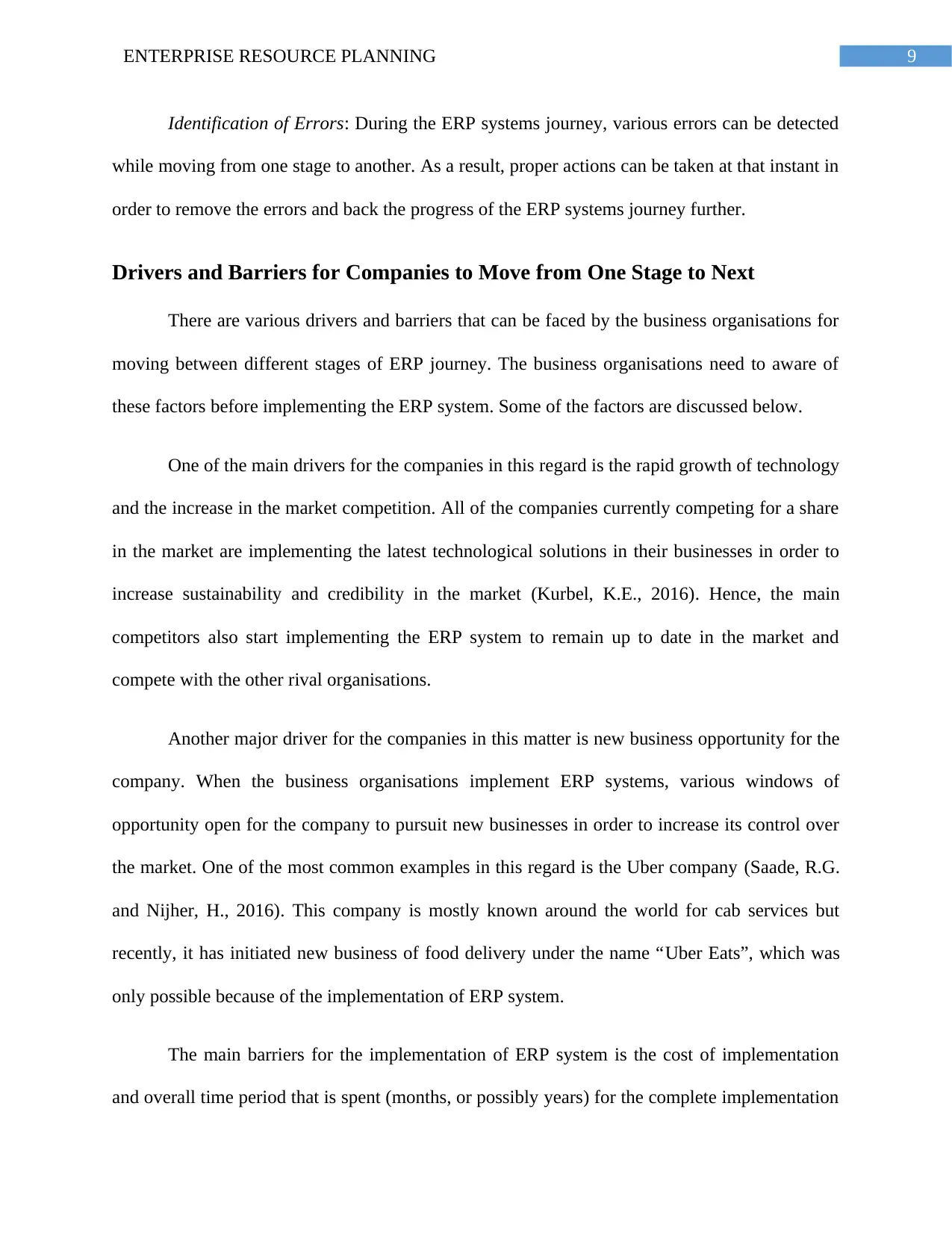
9ENTERPRISE RESOURCE PLANNING
Identification of Errors: During the ERP systems journey, various errors can be detected
while moving from one stage to another. As a result, proper actions can be taken at that instant in
order to remove the errors and back the progress of the ERP systems journey further.
Drivers and Barriers for Companies to Move from One Stage to Next
There are various drivers and barriers that can be faced by the business organisations for
moving between different stages of ERP journey. The business organisations need to aware of
these factors before implementing the ERP system. Some of the factors are discussed below.
One of the main drivers for the companies in this regard is the rapid growth of technology
and the increase in the market competition. All of the companies currently competing for a share
in the market are implementing the latest technological solutions in their businesses in order to
increase sustainability and credibility in the market (Kurbel, K.E., 2016). Hence, the main
competitors also start implementing the ERP system to remain up to date in the market and
compete with the other rival organisations.
Another major driver for the companies in this matter is new business opportunity for the
company. When the business organisations implement ERP systems, various windows of
opportunity open for the company to pursuit new businesses in order to increase its control over
the market. One of the most common examples in this regard is the Uber company (Saade, R.G.
and Nijher, H., 2016). This company is mostly known around the world for cab services but
recently, it has initiated new business of food delivery under the name “Uber Eats”, which was
only possible because of the implementation of ERP system.
The main barriers for the implementation of ERP system is the cost of implementation
and overall time period that is spent (months, or possibly years) for the complete implementation
Identification of Errors: During the ERP systems journey, various errors can be detected
while moving from one stage to another. As a result, proper actions can be taken at that instant in
order to remove the errors and back the progress of the ERP systems journey further.
Drivers and Barriers for Companies to Move from One Stage to Next
There are various drivers and barriers that can be faced by the business organisations for
moving between different stages of ERP journey. The business organisations need to aware of
these factors before implementing the ERP system. Some of the factors are discussed below.
One of the main drivers for the companies in this regard is the rapid growth of technology
and the increase in the market competition. All of the companies currently competing for a share
in the market are implementing the latest technological solutions in their businesses in order to
increase sustainability and credibility in the market (Kurbel, K.E., 2016). Hence, the main
competitors also start implementing the ERP system to remain up to date in the market and
compete with the other rival organisations.
Another major driver for the companies in this matter is new business opportunity for the
company. When the business organisations implement ERP systems, various windows of
opportunity open for the company to pursuit new businesses in order to increase its control over
the market. One of the most common examples in this regard is the Uber company (Saade, R.G.
and Nijher, H., 2016). This company is mostly known around the world for cab services but
recently, it has initiated new business of food delivery under the name “Uber Eats”, which was
only possible because of the implementation of ERP system.
The main barriers for the implementation of ERP system is the cost of implementation
and overall time period that is spent (months, or possibly years) for the complete implementation
Paraphrase This Document
Need a fresh take? Get an instant paraphrase of this document with our AI Paraphraser
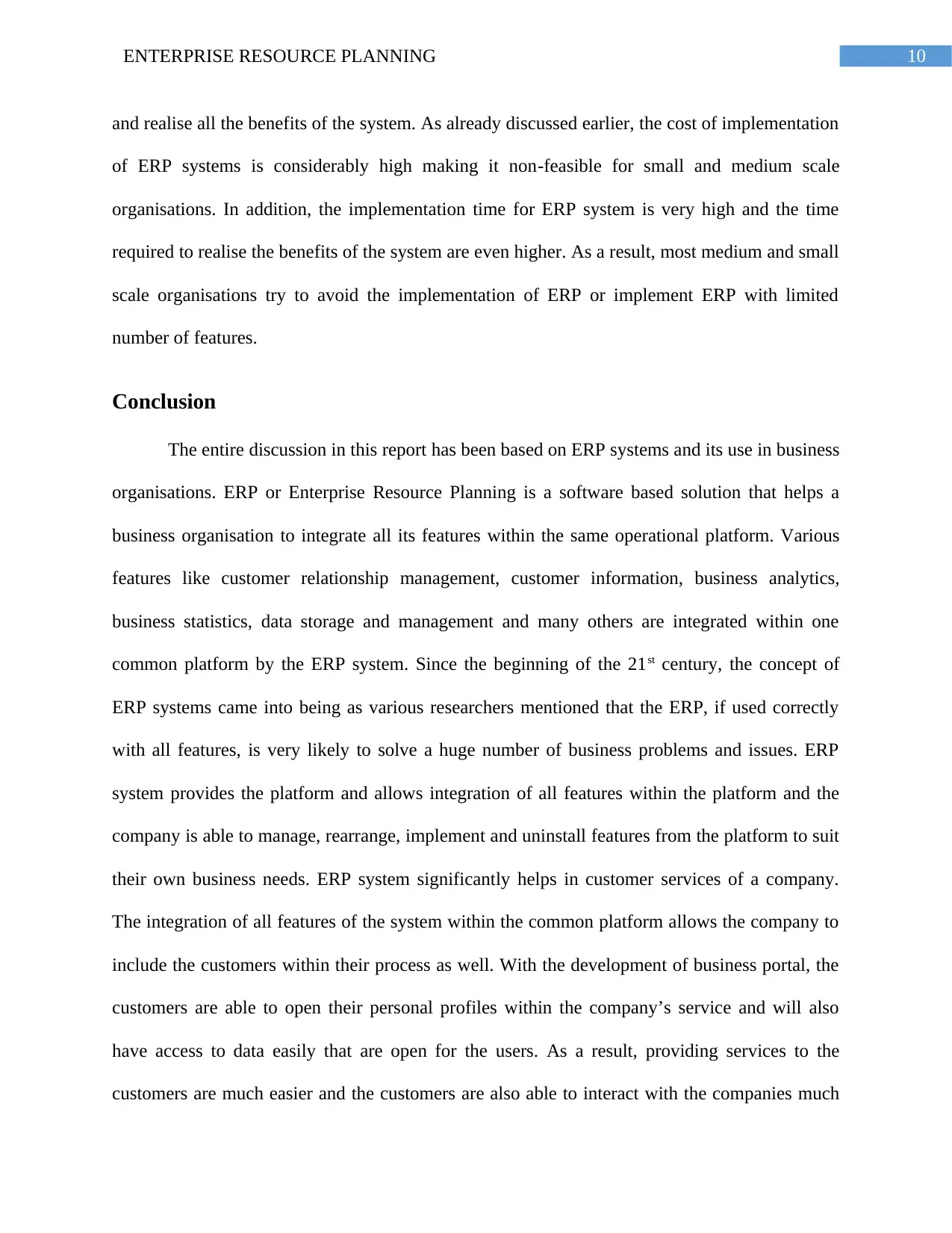
10ENTERPRISE RESOURCE PLANNING
and realise all the benefits of the system. As already discussed earlier, the cost of implementation
of ERP systems is considerably high making it non-feasible for small and medium scale
organisations. In addition, the implementation time for ERP system is very high and the time
required to realise the benefits of the system are even higher. As a result, most medium and small
scale organisations try to avoid the implementation of ERP or implement ERP with limited
number of features.
Conclusion
The entire discussion in this report has been based on ERP systems and its use in business
organisations. ERP or Enterprise Resource Planning is a software based solution that helps a
business organisation to integrate all its features within the same operational platform. Various
features like customer relationship management, customer information, business analytics,
business statistics, data storage and management and many others are integrated within one
common platform by the ERP system. Since the beginning of the 21st century, the concept of
ERP systems came into being as various researchers mentioned that the ERP, if used correctly
with all features, is very likely to solve a huge number of business problems and issues. ERP
system provides the platform and allows integration of all features within the platform and the
company is able to manage, rearrange, implement and uninstall features from the platform to suit
their own business needs. ERP system significantly helps in customer services of a company.
The integration of all features of the system within the common platform allows the company to
include the customers within their process as well. With the development of business portal, the
customers are able to open their personal profiles within the company’s service and will also
have access to data easily that are open for the users. As a result, providing services to the
customers are much easier and the customers are also able to interact with the companies much
and realise all the benefits of the system. As already discussed earlier, the cost of implementation
of ERP systems is considerably high making it non-feasible for small and medium scale
organisations. In addition, the implementation time for ERP system is very high and the time
required to realise the benefits of the system are even higher. As a result, most medium and small
scale organisations try to avoid the implementation of ERP or implement ERP with limited
number of features.
Conclusion
The entire discussion in this report has been based on ERP systems and its use in business
organisations. ERP or Enterprise Resource Planning is a software based solution that helps a
business organisation to integrate all its features within the same operational platform. Various
features like customer relationship management, customer information, business analytics,
business statistics, data storage and management and many others are integrated within one
common platform by the ERP system. Since the beginning of the 21st century, the concept of
ERP systems came into being as various researchers mentioned that the ERP, if used correctly
with all features, is very likely to solve a huge number of business problems and issues. ERP
system provides the platform and allows integration of all features within the platform and the
company is able to manage, rearrange, implement and uninstall features from the platform to suit
their own business needs. ERP system significantly helps in customer services of a company.
The integration of all features of the system within the common platform allows the company to
include the customers within their process as well. With the development of business portal, the
customers are able to open their personal profiles within the company’s service and will also
have access to data easily that are open for the users. As a result, providing services to the
customers are much easier and the customers are also able to interact with the companies much

11ENTERPRISE RESOURCE PLANNING
better. Hence, the business organisations that have been rapidly growing need to upgrade their IT
and implement ERP for the sake of gaining sustainability and strong growth in the market.
better. Hence, the business organisations that have been rapidly growing need to upgrade their IT
and implement ERP for the sake of gaining sustainability and strong growth in the market.
⊘ This is a preview!⊘
Do you want full access?
Subscribe today to unlock all pages.

Trusted by 1+ million students worldwide
1 out of 14
Related Documents
Your All-in-One AI-Powered Toolkit for Academic Success.
+13062052269
info@desklib.com
Available 24*7 on WhatsApp / Email
![[object Object]](/_next/static/media/star-bottom.7253800d.svg)
Unlock your academic potential
Copyright © 2020–2025 A2Z Services. All Rights Reserved. Developed and managed by ZUCOL.





